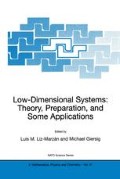Abstract
The intense study devoted to metal nanoparticles is motivated by their extremely interesting optical properties. Such properties have already been described by Faraday some 150 years ago [1], and still give raise to hundreds of scientific articles every year. The origin of such a special optical behaviour can be found in the interaction between incoming light and the free conduction electrons [2], When the wavelength of light couples with the oscillation frequency of the conduction electrons, a so-called plasmon resonance arises, which is manifested as an intense absorption band. The most spectacular cases are found when such plasmon resonance band exists in the visible wavelength range, since then the dispersions of metal nanoparticles display brilliant colours. The precise wavelength of the plasmon resonance depends on several parameters, among which particle size and shape, surface charge, and the nature of the environment are probably the most important ones [3].
Access this chapter
Tax calculation will be finalised at checkout
Purchases are for personal use only
Preview
Unable to display preview. Download preview PDF.
References
Faraday, M. (1857) Experimental relations of gold (and other metals) to light, Philos. Trans. Roy. Soc. ion. 147, 145–181.
Kreibig, U. and Vollmer, M. (1995) Optical Properties Of Metal Clusters, Springer Verlag, Berlin.
Mulvaney, P. (1996) Surface Plasmon spectroscopy of nanosized metal particles, Langmuir 12, 788–800.
Pastoriza-Santos, I. and Liz-Marzán, L. M. (2002) Synthesis of Silver Nanoprisms in DMF, Nano Lett., in press.
Pastoriza-Santos, I. and Liz-Marzán, L. M. (2000) Reduction of silver nanopartides in DMF. Formation of monolayers and stable colloids, Pure Appl. Chem. 72, 83–90.
Pastoriza-Santos, I. and Liz-Marzán, L. M. (1999) Formation and stabilization of silver nanopartides through reduction by N,N-dimethylformamide, Langmuir 15, 948–951.
Pastoriza-Santos, I., Koktysh, D., Mamedov, A. A., Giersig, M., Kotov, N. A., and Liz-Marzán, L. M. (2000) One-pot synthesis of Ag@TiO2 core-shell nanoparticles and their layer-by-layer assembly, Langmuir 16, 2731–2735.
Pastoriza-Santos, I. and Liz-Marzán, L. M. (2002) Preparation of PVP-protected metal nanoparticles in DMF, Langmuir 18, 2888–2894.
van der Zande, B. M. I., Böhmer, M. R., Fokkink, L. G., and Schöneberger, C. (2000) Colloidal dispersions of gold rods: synthesis and optical properties, Langmuir 2000, 16, 451-458.
Link, S., Mohamed, M. B., and El-Sayed, M. A. (1999) Simulation of the optical absorption spectra of gold nanorods as a function of their aspect ratio and the effect of the medium dielectric constant, J. Phys. Chem. B 103, 3073–3077.
Chang, S. S., Shin, C. W., Chen, C. D., Lai, W. C., and Wang, C. R. C. (1999) The shape transition of gold nanorods, Langmuir 15, 701–709.
Malikova, N., Pastoriza-Santos, I., Schierhorn, M., Kotov, N. A., and Liz-Marzân, L. M. (2002) Layer-by-layer assembled mixed spherical and planar gold nanoparticles: control of interparticle interactions, Langmuir 18, 3694–3697.
Jin, R.C., Cao, Y. W., Mirkin, C. A., Kelly, K. L, Schatz, G. C., and Zheng, J. G. (2001) Photoinduced conversion of silver nanospheres to nanoprisms, Science 294, 1901–1903.
Sun, Y., Gates, B., Mayers, B., and Xia. Y. (2002) Crystalline silver nanowires by soft solution processing, Nano Lett. 2, 165–168.
Fievet, F., Lagier, J. P., Figlarz, M. (1989) Preparing monodisperse metal powders in micrometer and submicrometer sizes by the polyol process, MRS Bull, December, 29-34.
Pastoriza-Santos, I., Giersig, M., and Liz-Marzán, L. M., unpublished results.
Schatz, G. C. (2001) Electrodynamics of nonspherical noble metal nanoparticles and nanoparticles aggregates, J. Molec. Struct. (Theochem) 573, 73–80.
Ung, T., Giersig, M., Dunstan, D., Mulvaney, P. (1997) Spectroelectrochemistry of colloidal silver, Langmuir 13, 1773–1782.
Ung, T., Liz-Marzán, L. M., Mulvaney, P. (1999) Redox catalysis using Ag@SiO2 colloids, J. Phys. Chem. B 103, 6770–6773.
Ung, T., Liz-Marzán, L. M., Mulvaney, P. (2001) Optical properties of thin films of Au@SiO2 particles, J. Phys. Chem. B 105, 3441–3452.
Henrichs, S., Collier, C. P., Saykally, R. J., Shen, Y. R., Heath, J. R. (2000) The dielectric function of silver nanoparticles Langmuir monolayers compressed through the metal insulator transition, J. Am. Chem. Soc, 122, 4077–4083.
Chumanov, G., Sokolov, K., Cotton, T. M. (1996) Unusual extinction spectra of nanometer-sized silver particles arranged in two-dimensional arrays, J. Phys. Chem. 100, 5166–5168.
Kotov, N. A., Dekàny, I., and Fendler, J H. (1995) Layer-by-layer self-assembly of polyelectrolytesemiconductor nanoparticle composite films, J. Phys. Chem. 99, 13065–13069.
Decher, G. (1997) Fuzzy nanoassemblies: toward layered polymeric multicoinposites, Science 277, 1232–1237.
Ung, T., Liz-Marzàn, L. M., Mulvaney, P. (2002) Gold nanoparticle thin films, Colloid Surf A 202, 119–126.
Author information
Authors and Affiliations
Editor information
Editors and Affiliations
Rights and permissions
Copyright information
© 2003 Springer Science+Business Media Dordrecht
About this chapter
Cite this chapter
Pastoriza-Santos, I., Hamanaka, Y., Fukuta, K., Nakamura, A., Liz-MarzáN, L.M. (2003). Anisotropic Silver Nanoparticles: Synthesis and Optical Properties. In: Liz-Marzán, L.M., Giersig, M. (eds) Low-Dimensional Systems: Theory, Preparation, and Some Applications. NATO Science Series, vol 91. Springer, Dordrecht. https://doi.org/10.1007/978-94-010-0143-4_6
Download citation
DOI: https://doi.org/10.1007/978-94-010-0143-4_6
Publisher Name: Springer, Dordrecht
Print ISBN: 978-1-4020-1169-6
Online ISBN: 978-94-010-0143-4
eBook Packages: Springer Book Archive

